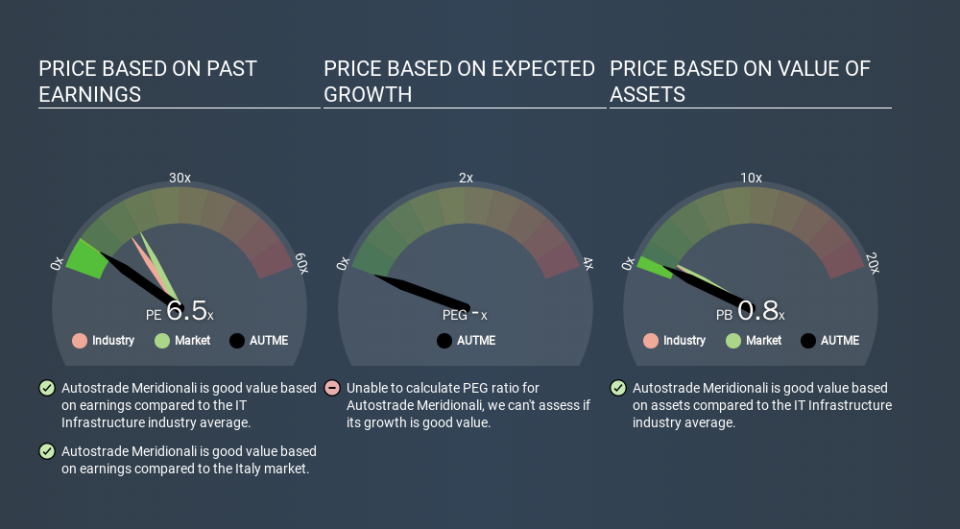Does Autostrade Meridionali S.p.A.'s (BIT:AUTME) P/E Ratio Signal A Buying Opportunity?

This article is written for those who want to get better at using price to earnings ratios (P/E ratios). We'll show how you can use Autostrade Meridionali S.p.A.'s (BIT:AUTME) P/E ratio to inform your assessment of the investment opportunity. What is Autostrade Meridionali's P/E ratio? Well, based on the last twelve months it is 6.53. In other words, at today's prices, investors are paying €6.53 for every €1 in prior year profit.
See our latest analysis for Autostrade Meridionali
How Do I Calculate A Price To Earnings Ratio?
The formula for price to earnings is:
Price to Earnings Ratio = Price per Share ÷ Earnings per Share (EPS)
Or for Autostrade Meridionali:
P/E of 6.53 = €31.10 ÷ €4.76 (Based on the trailing twelve months to June 2019.)
Is A High Price-to-Earnings Ratio Good?
The higher the P/E ratio, the higher the price tag of a business, relative to its trailing earnings. That is not a good or a bad thing per se, but a high P/E does imply buyers are optimistic about the future.
Does Autostrade Meridionali Have A Relatively High Or Low P/E For Its Industry?
The P/E ratio indicates whether the market has higher or lower expectations of a company. If you look at the image below, you can see Autostrade Meridionali has a lower P/E than the average (17.0) in the infrastructure industry classification.
This suggests that market participants think Autostrade Meridionali will underperform other companies in its industry. Since the market seems unimpressed with Autostrade Meridionali, it's quite possible it could surprise on the upside. It is arguably worth checking if insiders are buying shares, because that might imply they believe the stock is undervalued.
How Growth Rates Impact P/E Ratios
Earnings growth rates have a big influence on P/E ratios. When earnings grow, the 'E' increases, over time. That means unless the share price increases, the P/E will reduce in a few years. Then, a lower P/E should attract more buyers, pushing the share price up.
Autostrade Meridionali increased earnings per share by 9.2% last year. And earnings per share have improved by 49% annually, over the last five years.
A Limitation: P/E Ratios Ignore Debt and Cash In The Bank
Don't forget that the P/E ratio considers market capitalization. Thus, the metric does not reflect cash or debt held by the company. The exact same company would hypothetically deserve a higher P/E ratio if it had a strong balance sheet, than if it had a weak one with lots of debt, because a cashed up company can spend on growth.
Such spending might be good or bad, overall, but the key point here is that you need to look at debt to understand the P/E ratio in context.
So What Does Autostrade Meridionali's Balance Sheet Tell Us?
Net debt totals a substantial 164% of Autostrade Meridionali's market cap. This is a relatively high level of debt, so the stock probably deserves a relatively low P/E ratio. Keep that in mind when comparing it to other companies.
The Verdict On Autostrade Meridionali's P/E Ratio
Autostrade Meridionali's P/E is 6.5 which is below average (18.2) in the IT market. The meaningful debt load is probably contributing to low expectations, even though it has improved earnings recently.
When the market is wrong about a stock, it gives savvy investors an opportunity. As value investor Benjamin Graham famously said, 'In the short run, the market is a voting machine but in the long run, it is a weighing machine. We don't have analyst forecasts, but you could get a better understanding of its growth by checking out this more detailed historical graph of earnings, revenue and cash flow.
Of course you might be able to find a better stock than Autostrade Meridionali. So you may wish to see this free collection of other companies that have grown earnings strongly.
If you spot an error that warrants correction, please contact the editor at editorial-team@simplywallst.com. This article by Simply Wall St is general in nature. It does not constitute a recommendation to buy or sell any stock, and does not take account of your objectives, or your financial situation. Simply Wall St has no position in the stocks mentioned.
We aim to bring you long-term focused research analysis driven by fundamental data. Note that our analysis may not factor in the latest price-sensitive company announcements or qualitative material. Thank you for reading.

